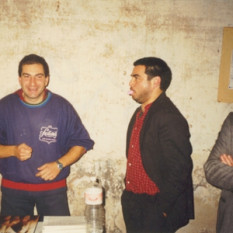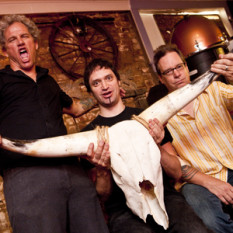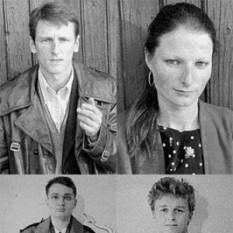Punk jazz describes the amalgamation of elements of the jazz tradition (usually free jazz and jazz fusion of the 1960s and 1970s) with the instrumentation or conceptual heritage of punk rock (typically the more experimental and dissonant strains, such as no wave and hardcore). John Zorn, James Chance and the Contortions, and Lounge Lizards are notable examples of punk jazz artists.
1960s:
The stylistic origins of punk rock are bound up with the reception of developments in jazz. The Velvet Underground, the Stooges, and the MC5, accepted as the roots of punk by experts such as Legs McNeil and Clinton Heylin, were all vocal in their fascination with, and at times direct sonic debt to jazz, and specifically the free jazz movement that began in the late 1950s. By the 1960s, avant-garde jazz musicians, such as Albert Ayler, Archie Shepp, Roscoe Mitchell, Sonny Sharrock, and Peter Brötzmann, were exploring much of the aggression, political themes, and DIY distribution efforts that would later become characteristic of punk rock.
1970s:
In 1970 The Stooges released Fun House, an album that was heavily instrumental in influencing the punk jazz sound. However, in 1970, punk rock was not yet cemented as a style, and as the decade progressed and the burgeoning punk scene came to be, it appeared to be in direct opposition with any "jazziness", and particularly the jazz fusion that had become intertwined with progressive rock. The emphasis on amateurism, speed, and brevity seemed to declare jazz elements anathema. Other developments in the jazz of the 1970s seemed equally far from the punk ethos, as ECM began to produce a calming, elegant, and refined variety of jazz at the antipodes of punk values. The exceptions to this stylistic divorce were Patti Smith, who (unsuccessfully) sought out collaboration with Ornette Coleman, and Television, who also developed a sinuous, improvisatory strain of punk, indebted to jazz. Lol Coxhill also recorded with the Damned. In Maine, The Same Band styled itself as a punk-jazz band, and was active from 1977-1980
1980s:
The relaxation of orthodoxy concurrent with post-punk in London and New York City led to a new appreciation for jazz. In London, the Pop Group began to mix free jazz, along with dub reggae, into their brand of punk rock. In NYC, No Wave took direct inspiration from both free jazz and punk. Examples of this style include Lydia Lunch's Queen of Siam, the work of James Chance and the Contortions, who mixed Soul with free jazz and punk and the Lounge Lizards, who were the first group to call themselves "punk jazz". Bill Laswell would become an important figure in punk jazz (in addition to his influence in dance-punk, dub and other genres) with his group Material, which mixed jazz-funk with punk, while another of his groups, Massacre, added an improvisational quality to aggressive rock music. Laswell would go on to take part in Last Exit and Pain Killer. James Blood Ulmer, who applied Ornette Coleman's harmolodic style to guitar, also sought out links to No Wave.
Bad Brains, widely acknowledged to have established the rudiments of the hardcore style, began by attempting jazz fusion. Greg Ginn of Black Flag also began to incorporate elements of free jazz into his guitar playing. Henry Rollins has praised free jazz, releasing albums by Matthew Shipp on his 2.13.61 label and collaborating with Charles Gayle.
Australian punk has a strong jazz punk tradition. The Laughing Clowns sought to create a free jazz "sheets of sound" aesthetic similar to that of Sun Ra, Pharoah Sanders, and John Coltrane. The early punk projects of Ollie Olsen also drew inspiration from free jazz, including Ornette Coleman. Nick Cave's The Birthday Party experimented with various jazz elements during the early 80s; their sound on Junkyard was described by one journalist as a mix of "no-wave guitar, free-jazz craziness, and punk-processed Captain Beefheart angularity". The efforts of these Australian punk bands has been described as "desert jazz".
Dutch anarcho-punk group the Ex also incorporated elements of free jazz and particularly European free improvisation, eventually collaborating with Han Bennink.
Greek-American singer Diamanda Galás also approached jazz tradition from a thematically and stylistically transgressive perspective. Her album The Singer is a prototypical example of punk jazz applied to vocals and piano performance. Nick Cave and the Bad Seeds bassist Barry Adamson recorded the album Moss Side Story, which also applies a punk and noise rock perspective to the orchestral jazz tradition, with Galás guesting on one track.
Jazzcore:
John Zorn began to make note of the emphasis on speed and dissonance that was becoming prevalent in punk rock and incorporated this into free jazz. This began in 1986 with the album Spy vs. Spy, a collection of Ornette Coleman tunes done in the contemporary thrashcore style. The same year, Sonny Sharrock, Peter Brötzmann, Bill Laswell, and Ronald Shannon Jackson recorded the first album under the name Last Exit, a similarly aggressive blend of thrash and free jazz.
These developments are the origins of jazzcore, the fusion of free jazz with hardcore punk. Groups like NoMeansNo, Massacre, and Naked City laid the foundations for what would later be described as math rock.
1990s:
In 1989, Zorn formed Naked City with Bill Frisell, Wayne Horvitz, Fred Frith, Joey Baron and Yamatsuka Eye. Taking inspiration from British grindcore and Japanese noise rock on their Torture Garden album, Naked City eventually became too polystylistic to be confined to the "punk jazz" tag. In 1991, Zorn also worked with former Napalm Death guitarist and drummer Justin Broadrick and Mick Harris, respectively, and Bill Laswell, in the group Pain Killer.
The Japanese group Ground Zero, formed by Otomo Yoshihide, pursued a similar, though even noisier and less accessible, variety of thrash-jazz. Mike Patton's group Mr. Bungle also began performing around this time, and also worked with John Zorn. Keiji Haino also worked in this vein.
At this point, punk jazz and jazzcore began to reflect the increasing awareness of elements of extreme metal (particularly thrash metal and death metal) in hardcore punk. Hardcore in the '90s began to reform itself as what's now known as metalcore. A new style of "metallic jazzcore" was developed by Iceburn, from Salt Lake City, and Candiria, from New York City, though anticipated by Naked City and Pain Killer. This tendency also takes inspiration from jazz inflections in technical death metal, such as the work of Cynic and Atheist.
Early screamo band Swing Kids experimented with jazz instruments, such as the piano and double bass, in addition to slower tempo drum work.
Candiria recorded their first album in 1995. While aware of Zorn's work, Candiria came from a different angle, combining NYHC metalcore with jazz fusion and East Coast hip-hop elements. Members of Candiria also formed an ambient/psychedelic jazz side-project in Ghosts of the Canal. The metallic jazzcore groups took greater inspiration from 1970s jazz fusion, in addition to or instead of earlier free jazz.
2000s:
Yakuza, from Chicago, are comparable to Candiria, combining contemporary metalcore with free jazz and psychedelia.
Other examples of punk jazz include Zu, The Flying Luttenbachers, Honey Ride Me a Goat, Midori, Off Minor, The Plot to Blow Up the Eiffel Tower, Deep Turtle, Rolo Tomassi, Phantom Tollbooth, and Red Square. .




